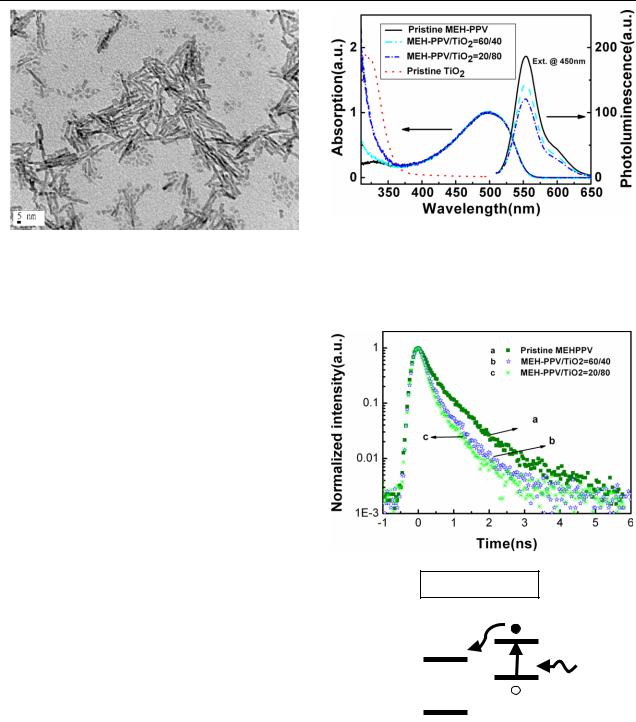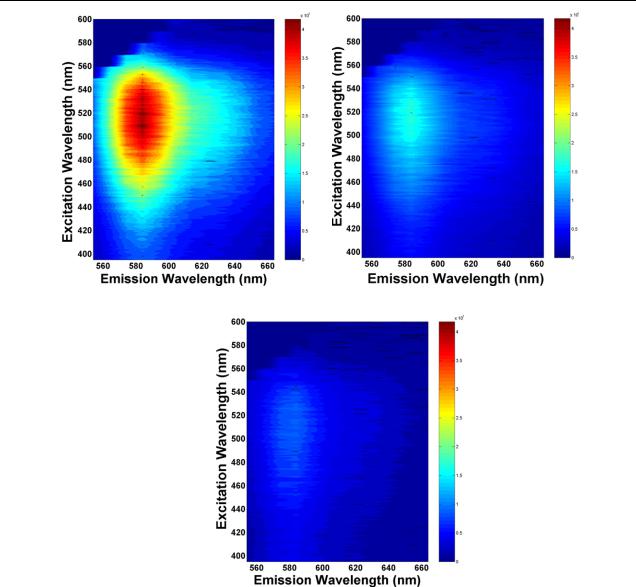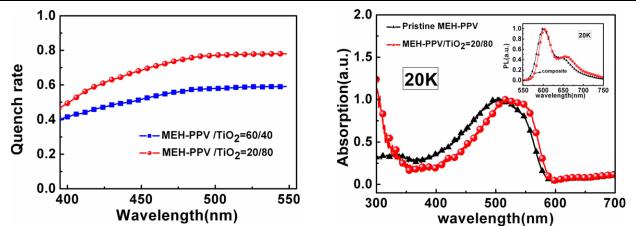

INSTITUTE OF PHYSICS PUBLISHING |
NANOTECHNOLOGY |
Nanotechnology 17 (2006) 5781–5785 |
doi:10.1088/0957-4484/17/23/012 |
Efficient photoinduced charge transfer in TiO2 nanorod/conjugated polymer hybrid materials
Yu-Ting Lin, Tsung-Wei Zeng, Wei-Zong Lai, Chun-Wei Chen1,
Yun-Yue Lin, Yu-Sheng Chang and Wei-Fang Su1
Department of Materials Science and Engineering, National Taiwan University, Taipei, Taiwan
E-mail: chunwei@ntu.edu.tw and suwf@ntu.edu.tw
Received 23 September 2006, in final form 17 October 2006
Published 10 November 2006
Online at stacks.iop.org/Nano/17/5781
Abstract
The mechanisms of photoinduced charge transfer in composites of TiO2 nanorods with a conjugated polymer (poly(2-methoxy-5-(2 -ethyl)(hexyloxy) 1,4-phenylenevinylene) (MEH-PPV) have been investigated by steady-state, time-resolved photoluminescence (PL) spectroscopy and photoluminescence excitation (PLE) spectroscopy. Efficient charge separation takes place at the TiO2-nanorod/polymer interfaces when the polymer is excited, leading to quenching of the photoluminescence efficiency η and shortening of the measured lifetime τPL. In addition, the low-temperature absorption and photoluminescence spectra show that the inclusion of TiO2 nanorods in polymer can reduce disorder in conformation and enhance conjugation in the polymer chain. A photovoltaic solar cell device based on the MEH-PPV/TiO2-nanorod composite material is also presented, which shows a two order increase in short-circuit current JSC compared to that based on the pristine MEH-PPV.
(Some figures in this article are in colour only in the electronic version)
1. Introduction
Recently, composites of organic polymers and inorganic nanoparticles have attracted great interest due to their potential application in developing low-cost, large-area, mechanically flexible photovoltaic devices [1, 2]. A basic requirement for a photovoltaic material is to generate free charge carriers produced by photoexcitation. Subsequently, these carriers are transported through the device to the electrodes without recombining with oppositely charged carriers. Due to the low dielectric constant of organic materials, the dominant photogenerated species in most conjugated polymers is a neutral bound electron–hole pair (exciton). These neutral excitons can be dissociated from Coulomb attraction by offering an energetically favourable pathway for the electron from polymer (donor) to transfer to an electron-accepting species (acceptor). Charge separation in the polymer is often enhanced by inclusion of a high-electron-affinity substance
1 Authors to whom any correspondence should be addressed.
such as the fullerene derivative [6,6]-phenyl-C61 butyric acid methyl ester (PCBM) [3, 4], organic dyes [5, 6], or nanocrystals [1, 7]. Nanocrystals are considered to be more attractive in photovoltaic applications due to their large surface-to-bulk ratio, giving an extension of interfacial area for electron transfer, and higher stability. The charge separation process must be fast compared to radiative or nonradiative decays of the singlet exciton, leading to quenching of the photoluminescence (PL) intensities. However, electron transport in the polymer/nanoparticle hybrid is usually limited by poorly formed conduction path [7]. Thus, one-dimensional semiconductor nanorods are preferable over nanoparticles for offering direct pathways for electric conduction. It has been demonstrated that the solar cell based on the CdSe nanorod/poly(3-hexylthiophene) (P3HT) hybrid material exhibits better power conversion efficiency than its CdSe nanoparticle counterpart [1]. The environmentally friendly and low-cost TiO2 nanocrystal is another promising material in hybrid polymer/nanocrystal solar cell applications [8, 9]. In this report, the microscopic mechanisms of photo-
0957-4484/06/235781+05$30.00 © 2006 IOP Publishing Ltd Printed in the UK |
5781 |

Y-T Lin et al
Figure 1. TEM image of TiO2 nanorods with a size of 4–5 nm in diameter and 20–40 nm in length.
induced charge transfer in the MEH-PPV/TiO2-nanorod hybrid materials are investigated by stead-state and time-resolved photoluminescence (PL) spectroscopy and photoluminescence excitation (PLE) spectroscopy. Finally, the current–voltage characteristic of a photovoltaic device based on the MEHPPV/TiO2 nanorod hybrid material is also reported.
2. Experimental methods
The controlled growth of high-aspect-ratio anatase titanium dioxide nanorods were synthesized by the hydrolysis of titanium tetraisopropoxide according to the literature [10]. Typically, oleic acid (120 g, Aldrich, 90%) was stirred vigorously at 120 ◦ C for 1 h in a three-neck flask under Ar flow, then allowed to cool to 90 ◦ C and maintained at this temperature. Titanium isopropoxide (17 mmol, Aldrich, 99.999%) was then added into the flask. After stirring for 5 min, trimethylamine-N -oxide dihydrate (34 mmol, ACROS, 98%) in 17 ml of water was injected rapidly. The trimethylamine-N-oxide dihydrate was used as a catalyst for polycondensation. The reaction was continued for several hours to have complete hydrolysis and crystallization. Finally, TiO2 nanorods were obtained with a size of about 4 nm in diameter and 20–40 nm in length. The product was washed and precipitated by ethanol repeatedly to remove residual surfactant. Subsequently, the TiO2 nanorods were collected by centrifugation and then re-dispersed in chloroform or toluene. In the preparation of hybrid materials, the MEH-PPV solution was prepared by dissolving MEH-PPV (Aldrich, USA) in chloroform. Solutions of hybrid materials with 0, 40 and 80 wt% TiO2 were obtained by mixing the required amount of TiO2 nanorod solution with the MEH-PPV solution. Thinfilm samples of hybrid material were prepared by spin coating the hybrid solution on silicon substrates and further annealed in vacuum before measurements.
UV–visible absorption spectra were obtained using an
Ocean Optics HR-4000 spectrometer. |
The steady-state |
PL spectra were measured by using a |
Perkin-Elmer FS- |
55 spectrofluorometer. Time-resolved photoluminescence spectroscopy was performed with a time-correlated single photon counting (TCSPC) spectrometer (Picoquant Inc.). A
Figure 2. (a) Absorption and photoluminescence spectra of blends of MEH-PPV with TiO2 nanorods for increasing concentrations of TiO2 nanorods: (a) 0 wt%, (b) 40 wt%, (c) 80 wt%. (d) Absorption spectrum of TiO2 nanorods only.
(a)
(b)
Charge transfer
-3.0eV (LUMO)
-4.2eV (CB)
hv
-5.3eV (HOMO)
-7.4eV (VB)
TiO2 MEH-PPV
Figure 3. (a) Photoluminescence lifetime decay of theses samples at room temperature. The lifetime τPL for the pristine MEH-PPV and the composites containing 40 and 80 wt% TiO2 nanorods are 738, 520 and 497 ps, respectively, by a bi-exponential fitting.
(b) Schematic representation of charge transfer at the MEH-PPV/TiO2-nanorod interfaces. The vacuum level is defined at 0 eV.
pulse laser (375 nm) with an average power of 1 mW operating at 40 MHz with a duration of 70 ps was used for excitation.
5782

Efficient photoinduced charge transfer in TiO2 nanorod/conjugated polymer hybrid materials
(a) |
(b) |
(c)
Figure 4. Two-dimensional contour plots of the photoluminescence mapping as a function of emission and excitation wavelengths for composite films with (a) 0 wt%, (b) 40 wt%, and (c) 80 wt% of TiO2 nanorod concentrations. To avoid the second-harmonic effect, detection of the emission wavelength is limited to less than twice the excitation wavelength.
During the temperature-dependent PL measurements, the samples were maintained under vacuum inside a helium cryostat, allowing temperature variation between 10 K and ambient temperature. PLE spectroscopy was measured using a FluoroLog®-3 spectrofluorometer (Jobin-Yvon). Film thickness was measured by means of a Veeco M6 surface profiler. Current–voltage characterizations (Keithley 2400 source meter) were performed under a 10−3 Torr vacuum and under monochromatic illumination at a defined beam size (Oriel Inc.).
3. Results and discussions
In this study, TiO2 nanorods of 20–40 nm in length and 4–5 nm in diameter are used. Figure 1 shows transmission electron microscopy (TEM) images of the TiO2 nanorods
before being blended with MEH-PPV. Figure 2(a) shows the room-temperature UV–visible absorption and PL spectra of the various blends of MEH-PPV with 0, 40, and 80 wt% of TiO2 nanorods, respectively. To avoid thickness and geometry effects, the optical density of absorption and PL intensity was measured in solution within cuvette cells. The pristine MEH-PPV exhibits a broad absorption spectrum peaked at about 490 nm and TiO2 nanorods have a sharp absorption edge at about 350 nm. As the concentration of the TiO2 nanorods increases, the optical density of the absorption spectra in the composites is simply the sum of the absorption spectra of constituent parts. No evidence of any additional absorption peaks in the measured spectral range is found. With excitation at 450 nm, only the polymer is excited and the PL spectra of the composites show similar emission features with respect to that of the pristine MEH-PPV, indicating that
5783

Y-T Lin et al
Figure 5. The quenching efficiency Q(λ) as a function of excitation wavelengths for the composites with respect to pristine MEH-PPV.
the luminescence predominantly results from excitons which radiatively recombine in polymer. However, the yield of the PL emission in the composites decreases substantially with increasing TiO2 nanorod content, indicating that charge separation occurs at the interface between the two materials. This produces a charge-separated state with an electron on the TiO2 nanorod and a hole on the polymer, which is responsible for the polymer emission quenching. Figure 3(a) presents the PL decay spectroscopy for the hybrid materials measured at 550 nm. The PL decay in the composite materials demonstrates a monotonic decrease in lifetime with increasing TiO2 nanorod content. The measured lifetime of the luminescence τPL can be related to the rate constants for radiative and non-radiative
decays, kR and kNR, by 1/τPL |
=R |
+ |
kNR. The PL efficiency |
|
kR |
|
|||
η is then given by η = f |
k |
= f (τPL/τR), where f |
||
kR+kNR |
|
|||
is the fraction of absorbed photons generating the emissive species and τR = 1/ kR is the natural radiative lifetime, i.e. the lifetime that the luminescence would have in the absence of a competing non-radiative decay process. As the TiO2 nanorod concentration increases, a new relaxation process is present, which provides to the donor a further nonradiative process, leading to the enhancement of the nonradiative decay rate kNR. This leads to a shortening of the measured lifetime τPL and quenching of the PL efficiency η. Figure 3(b) exhibits schematically the mechanism of charge transfer at the MEH-PPV/TiO2-nanorod interfaces. By taking the PL efficiency of the pristine MEH-PPV as 100% and the natural radiative lifetime as τ0 for reference, the relative natural radiative lifetime τR for the composites calculated according to η = f (τPL/τR) can be estimated to be about 1.09τ0 and 1.12τ0 for the samples containing 40 and 80 wt% nanorods, respectively. The increase in natural radiative lifetime, τR, for the composites with respect to the pristine MEH-PPV implies that the excitons, which contribute to the remaining luminescence by radiative recombination in the polymer, will migrate along the polymer chains over a larger region before recombination.
The two-dimensional PL contour plots of the composite thin films with 0, 40, and 80 wt% of TiO2 nanorod concentrations as a function of emission and excitation wavelengths are shown in figures 4(a)–(c), respectively. The
Figure 6. Normalized absorption spectra measured at 20 K of the pristine MEH-PPV and the composite film with 80 wt% of TiO2 nanorods. The inset exhibits the normalized PL spectra for the composite and pristine MEH-PPV measured at 20 K.
excitation wavelengths were chosen to keep the condition that only the polymer absorbs the light intensity. These samples are prepared by spin-coating the mixture of MEH-PPV and TiO2 nanorods onto Si substrates. The film thickness for these samples was about 120 ± 10 nm. For the pristine MEHPPV, the PL maxima (spots) on the map in figure 4(a) are clearly seen at about 570–590 nm, consistent with the PL emission peak in figure 2(a). As the concentrations of TiO2 nanorods are increased up to 40 and 80 wt%, as shown in figures 4(b) and (c) respectively, the intensities of the PLE signals quench at all emission wavelengths, indicating that efficient charge separation occurs at the TiO2-nanorod/MEH- PPV interfaces. Figure 5 shows the quenching efficiency Q(λ) as a function of excitation wavelength from 400 to 550 nm for the composites with respect to pristine MEH-PPV. The quenching rate is enhanced with increasing TiO2 nanorod content in the composite films. For excitation with a longer wavelength closer to the PL emission peak, the quench rate is also increased. In addition, it is worth noting that the fluorescence quenching for the composite thin films is more efficient with respect to the mixed solutions in our case. Similar observation has also been reported previously [7, 11], where the possible formation of nanocrystal aggregation may take place in solutions or thicker films.
We have further characterized the optical properties of the composite films at low temperature. Figure 6(a) shows the absorption spectra of pristine MEH-PPV and the composite film with a 80 wt% TiO2 nanorod concentration, respectively, measured at 20 K. As shown in figure 2(a), a similar absorption peak at about 500 nm is observed for these two samples. As the temperature is lowered to 20 K, there is a significant redshift in the absorption spectrum for the composite film with respect to pristine MEH-PPV. The effective conjugation length in polymer chains increases with decreasing temperature, owing to the reduction in thermal disorder. Accordingly, enhancement in the delocalization of the π -electrons brings the absorption peaks to lower energies as the temperature is lowered [12]. For the composite film, a larger red-shift in the absorption peak at low temperature with respect to pristine MEH-PPV indicates that the inclusion of TiO2 nanorods
5784
